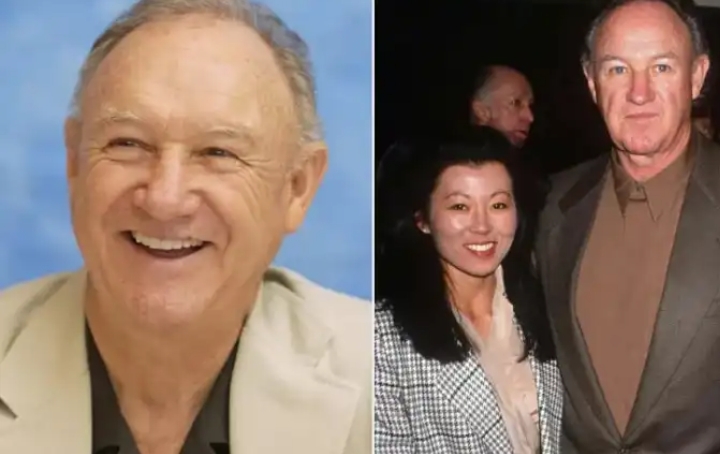By Kayode Sanni-Arewa
Mendoza added there was no immediate indication of foul play in the deaths, the outlet added.
The actor and his wife, classical pianist Betsy Arakawa, were found dead at their home in Santa Fe Summit on Wednesday, Feb. 26, reported the Santa Fe New Mexican, citing County Sheriff Adan Mendoza, who confirmed to the outlet that the couple had died, along with their dog
Mendoza added there was no immediate indication of foul play in the deaths, the outlet added.
He also did not provide a cause of death or say when the couple, who were married for over 30 years, might have died.
Born Eugene Allen Hackman in San Bernardino, California, in 1930, he moved frequently with his family, eventually landing in Danville, Illinois, where his father worked for a newspaper press.
As a boy, Hackman often found himself escaping to movie theatres, where he idolized stars like Erroll Flynn, Edward G. Robinson and his favourite, Jimmy Cagney.
When Hackman was 13, his father left the family, waving a hand to his son as he left.
“It was so precise. Maybe that’s why I became an actor,” Hackman once told Vanity Fair in 2013 of that parting gesture.
“I doubt I would’ve become so sensitive to human behaviour if that hadn’t happened to me as a child — if I hadn’t realized how much one small gesture can mean.”
Three years later, after a night in jail for stealing candy and soda, Hackman enlisted in the Marines, serving until he was 19.
After his discharge, he bounced around, living in New York, Florida, and his childhood home, Danville, and marrying his girlfriend, Faye Maltese, in 1956. (They would divorce 30 years later.)
The pair later moved to California, where Hackman joined the famed Pasadena Playhouse.
While there, Hackman forged a friendship with another aspiring actor, Dustin Hoffman.
Hackman, however, was kicked out of the Playhouse and, deciding to prove them wrong, headed to New York City, where he was determined to make it as an actor.
He landed a small part in a two-week production of Arthur Miller’s play: “A View from the Bridge.”
In New York, Hackman kicked around for years, hanging out with Hoffman and Robert Duvall, taking small parts as they came.
It wasn’t until he was in his mid-thirties that Hackman finally landed a role that got him noticed, playing Warren Beatty‘s brother in Bonnie and Clyde (1967).
As Buck Barrow in the incendiary film, Hackman earned his first Oscar nomination in 1968 out of five.
Three years later, Hackman was nominated for a second Best Supporting Actor Oscar for his role in the 1970’s I Never Sang for My Father. But it was his leading role in 1971’s The French Connection that solidified his status as a Hollywood leading man and earned him the Oscar for Best Actor in 1972.
Hackman pursued more diverse roles in 1972’s The Poseidon Adventure, Francis Ford Coppola’s 1974 film The Conversation (1974) where Hackman plays a surveillance expert who thinks a couple is about to be murdered.
He also portrayed a hard-charging coach in 1986’s Hoosiers, the war-mongering submarine captain in Crimson Tide (1995).
And he was Lex Luthor in the 1978 film Superman, which may have seemed an odd choice of vehicle for a man bent on making his bones as a serious actor, but with more than 80 movies on his resume, Hackman made room for silliness.
For every bit of fun like the animated film Antz (1998) or The Birdcage (1996) with Robin Williams and Nathan Lane, there were indelible turns in Mississippi Burning, which earned Hackman his fourth Academy Award nomination in 1989, and Clint Eastwood’s Unforgiven, for which Hackman took home his second Oscar in 1993, as a loathsome sheriff.
Hackman retired from acting after starring in the 2004 comedy Welcome to Mooseport. Just a few years before, he’d once again thrilled audiences in Wes Anderson’s The Royal Tenenbaums as the dying patriarch of a family of kooky geniuses (including Anjelica Huston, Gwyneth Paltrow, Ben Stiller and Luke Wilson). But after a career that spanned cinema’s rebirth in the late ’60s to the new century, Hackman decided he’d done enough.
In 2004, Hackman told Larry King in an interview that his career was “probably all over,” and that he had no new scripts in front of him. Confirming his retirement in 2008, he expanded on his thoughts several years later, telling GQ in 2011 that it would take a lot for him to make another film.
“I don’t know. If I could do it in my own house, maybe, without them disturbing anything and just one or two people,” he said, later telling the outlet that he just hopes to be remembered “as a decent actor.”
While on a book tour for his novel Escape from Andersonville in 2008, Hackman told the Raleigh News & Observerhe didn’t want to “keep pressing” and risk “going out on a sour note. “I feel comfortable with what I’ve done,” he said.
Hackman turned to painting and did voice-over work and writing books. He penned the old west story Payback at Morning Peak (2011) and the police thriller Pursuit (2013), as well as co-authoring three works of historical fiction with undersea archeologist Daniel Lenihan.
He has since narrated two documentary films: The Unknown Flag Raiser of Iwo Jim (2016) and We, the Marines (2017).
In addition to one of the most staggering filmographies in the business, his writing, theater notices and his painting, Hackman leaves behind his three children who he shared with his first wife, Maltese: Christopher Allen, Elizabeth Jean and Leslie Ann Hackman.
Asked by GQ in 2011 as to how he would like to be remembered, Hackman humbly replied, “As a decent actor. As someone who tried to portray what was given to them in an honest fashion. I don’t know, beyond that.” [People]

